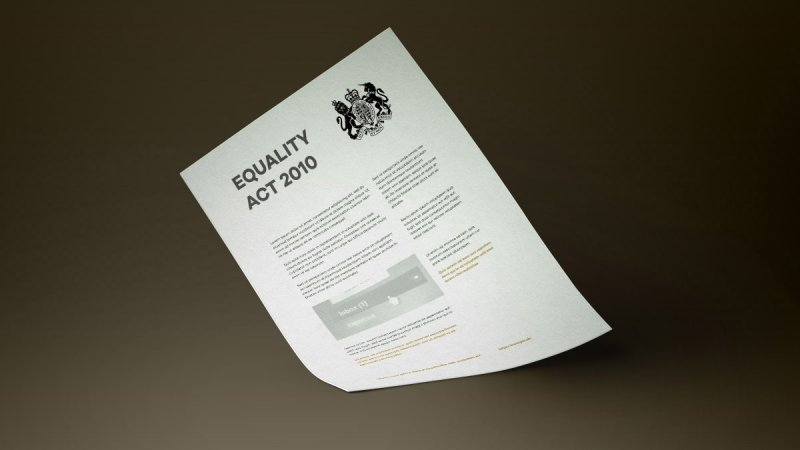The UK legislation around equality and diversity comes in the form of the Equality Act 2010. Hailed as a landmark in the topic of discrimination legislation, it works to protect people from discrimination in the workplace (as well as in wider society). The act pushes for a consistency across the business world so that employees and employers all comply with the laws to create fairer workplaces up and down the country.
The act impacts everyone to make sure that employers create policies that are compliant. However, it tends to be the smaller companies that are less likely to have a clear anti-discrimination policy, so the act has a greater impact on them. The aim is to ensure employers and employees benefit from a much fairer working environment as a result.
Elements of the Equality Act
The act brings together over 116 separate pieces of legislation in an attempt to simplify and strengthen the rules around the topic. The act provides a legal framework to protect the rights of individuals and push for equal opportunities for all in an attempt to protect employees from unfair treatment.
This ‘unfair treatment’ can come in the following forms:
- Direct discrimination: Treating people less favourably than others
- Indirect discrimination: Creating rules that apply to everyone, but actually put some at a disadvantage/in an uncomfortable position as a result
- Harassment: Unwanted behaviour that violates someone’s dignity or creates an offensive environment for them
- Victimisation: Treating someone unfairly if they’ve complained about discrimination
It promotes equality in the areas of 9 protected characteristics, also known as general duties to promote equality, and 9 of the main legislations that were incorporated into the act.
- The Equal Pay Act 1970
- The Sex Discrimination Act 1975
- The Race Relations Act 1976
- The Disability Discrimination Act 1995
- The Employment Equality (Religion or Belief) Regulations 2003
- The Employment Equality (Sexual Orientation) Regulations 2003
- The Employment Equality (Age) Regulations 2006
- The Equality Act 2006, Part 2
- The Equality Act (Sexual Orientation) Regulations 2007
As you can see, the main focuses of this act are the issues of age, disability, gender, race, religion and sexual orientation. Additionally from these issues, pregnancy and marriage could cause someone to be discriminated against. Anywhere that a quality can be used against someone to make them feel uncomfortable or ‘singled out’ is where discrimination can occur – something that prevents equality and diversity from being prominent within the workforce.

The Equality Act and You
The Act pushes for an increased transparency in payslips by making the secrecy clauses unenforceable. In other words, the firm can’t make the clauses secret, so can’t really stop people from talking about what they earn. These rules used to be included in a lot of contracts, attempting to prevent employees from discussing their pay, because discussing salary highlights the pay gap between men and women. By making pay much more transparent, the pay gap can be narrowed.
The Act also prevents employers from requesting a health form before offering the individual the position. This then prevents the decision being made on factors other than your work capability and skill.
Employment tribunals are another element of the Act that have a big impact on individuals. If an employee makes a claim, rather than just receiving financial compensation as a result, the response goes as far as making recommendations to the employer. This equates to a greater change because the employer is more likely to alter their behaviour if they are told to assess their policies and introduce employee training.
Compliant Culture
The importance of this Act cannot be stressed enough. By having national standards that organisations need to meet, a consistency is created throughout the whole process so that customers are treated fairly wherever they go.
By companies following these rules and regulations, they are showing that they comply with equality and diversity, creating a better system all round.
Promoting equality and diversity in the workplace means that companies can gain a more flexible and adaptive corporate culture by accessing a broader variety of worldviews and problem-solving styles. Another positive is that diverse workforces are perceived as more appealing to potential employees and customers.
Companies that want to push for diversity take the extra steps of scrutinizing their own policies and strategies to determine whether they are really doing everything they can to recruit a more varied workforce.
Starbucks 2016
Starbucks was shamed for discrimination recently when an employee won a disability case after she was accused of falsifying documents.
Meseret Kumulchew was discriminated when she made some written mistakes due to having dyslexia – mistakes that resulted in a big step down as she was told to retrain as well as being given simpler duties as they accused her of falsifying the documents.
The tribunal revealed that Starbucks had failed to make reasonable adjustments for her disability and therefore discriminated against her because of the actions that were a result of her dyslexia. It was also stressed that she was victimised by her employer.
The result is that Starbucks are in discussions around the idea of supplying more workplace support. Giving the employee longer to learn each task is exactly how they could have coped with this simply, something Ms Kumulchew says would have helped considerably.


